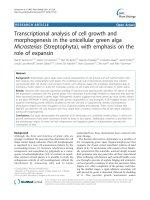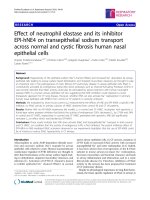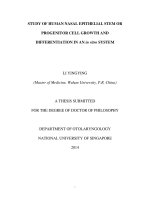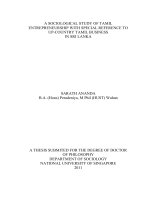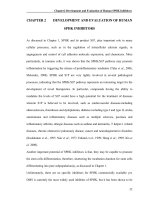Study of human nasal epithelial stem or progenitor cell growth and differentiation in an in vitro system
Bạn đang xem bản rút gọn của tài liệu. Xem và tải ngay bản đầy đủ của tài liệu tại đây (7.59 MB, 259 trang )
i
STUDY OF HUMAN NASAL EPITHELIAL STEM OR
PROGENITOR CELL GROWTH AND
DIFFERENTIATION IN AN in vitro SYSTEM
LI YINGYING
(Master of Medicine, Wuhan University, P.R. China)
A THESIS SUBMITTED
FOR THE DEGREE OF DOCTOR OF PHILOSOPHY
DEPARTMENT OF OTOLARYNGOLOGY
NATIONAL UNIVERSITY OF SINGAPORE
2014
ii
Declaration
I hereby declare that this thesis is my original work and it has
been written by me in its entirety. I have duly acknowledged
all the sources of information which have been used in the
thesis.
This thesis has also not been submitted for any degree in any
university previously
Li Yingying
2 Aug 2014
iii
Acknowledgement
First and foremost I want to thank my supervisor, Assoc. Prof. Wang De Yun. It
has been an honor to be his PhD student. He has taught me not only knowledge, but
also the philosophy of life. I still remember the scene that he asked me to spell the
full name of PhD and showed me how to understand the meaning of PhD when we
first met. During these four years, the joy and enthusiasm he has for his research
was contagious and motivational for me. I am also thankful for the excellent
example he has provided as a successful scientist and professor.
The members of the ENT research lab have contributed immensely to my personal
and professional time at NUS. This group has been a source of friendships as well
as good advice and collaboration. I am especially grateful for my senior, Dr. Li
Chun Wei. He helped me be familiar to many of research works with great patience
and selflessly shared with me some tips he picked up during his experience. I would
like to acknowledge the senior research fellow, Dr. Yu Feng Gang. I very much
appreciated his enthusiasm, intensity, willingness to share his knowledge on stem
cell culture and inspired me with amazing ideas. In addition, I would also thank
other members in this lab: Ms. Liu Jing, Dr. Yan Yan and Dr. Louise Tan Soo Yee.
Without their generous help and support, I could not fulfill my PhD work.
I must specially thank Assoc. Prof. Thomas Loh, our head of department, who
gives me a help and support in my study. I would also like to appreciate the help
from all the doctors in our department, especially Assoc. Prof. Chao Siew Shuen,
iv
who gives us a great support with clinic samples supply. I need to thank the sharing
of clinic ideas from Dr. Lim Chwee Ming and Dr. Ng Chew Lip.
Throughout my PhD study, we have many collaboration works with exchange-
students from China and I have had the pleasure moment to work with them. The
optimization of components and description of characteristics for hNESPCs was
mainly finished by Dr. Zhao Xue Ning from Shandong University (Shandong,
China). The differentiation study was also collaborated with her. For comparison
study for hNESPCs from NP and healthy controls, Dr. Yu Xue Ming from
Shandong University (Shandong, China) helped me to trace the proliferation of
progenitor cell. In my later work of cilia impairment in hyperplasia epithelium in
NP, Dr. Gao Tian from Haerbin medical University (Heilongjiang, China), Dr. Jin
Peng and Dr. Duan Chen from Shandong University (Shandong, China) help me a
lot in staining works.
Other peoples, who are not our major collaborators, also have given me a great help
in my work for these years. My lab neighbors, Ms. Wen Hong Mei, Dr. Huang
Chiung Hui, Dr. Kuo I-Chun, and Dr. Seow See Voon from Department of
Pediatrics always give me assistance and let me share the facilities with them. Ms.
Li Chun Mei from Department of Anaesthesia always lent me a hand with my
routine lab work. I should like to express my gratitude for your kindness
v
I also thank National University of Singapore for giving me the chance to pursue
PhD and offering me the scholarship.
And last but not least, this dissertation is dedicated to my family. My parents are
always standing with me and giving me endless love and encouragement. My
husband is always showing his patience and thoughtfulness to my work, and
teaching me how to simplify works by using software. Without their help and
support, it’s hard for me to persist during tough times in the PhD. It’s my fortune
to be your daughter/ wife.
Yours,
Li Yingying
vi
Table of Contents
Title i
Declaration ii
Acknowledgement iii
Publications and Presentations at Conferences 231
Publications 231
Presentations at Conferences 234
Table of Contents vi
Summary xii
List of Tables xv
List of Figures xvi
List of Abbreviations xxi
Chapter 1. Literature review 1
1.1. Chronic rhinosinusitis with NP 2
1.1.1. Epidemiology 3
1.1.1. Histopathology 4
1.1.2. Pathogenesis 5
1.1.3. Treatment 16
1.2. Nasal epithelium 16
1.2.1. Structure and bio-physiology 16
1.2.2. Epithelial impairment in NP 42
1.2.3. Update in research 49
vii
Chapter 2. Objectives of this study 59
2.1. Research questions 59
2.2. Objectives 62
2.3. Significance 62
Chapter 3. Material and Methods 64
3.1. Study subjects 64
3.2. Immunohistochemical staining (IHC) 65
3.2.1. Staining procedures for paraffin embedded tissues 66
3.2.2. Evaluation of IHC staining patterns 66
3.3. Cell preparation and fixed for Immunofluorescence 68
3.3.1. Progenitor cells 68
3.3.2. Differentiated cells in ALI culture 68
3.3.3. Cytospin 68
3.4. Immunofluorescence (IF) 68
3.5. Scanning electron microscopy 71
3.6. RNA extraction 71
3.6.1. Extract from solid tissues 71
3.6.2. Extract from cells 72
3.7. Microarray analysis 72
3.8. Real-Time quantitative reverse transcription PCR (RT- qPCR) 73
3.9. Tissue IF staining and mRNA evaluation in tissue section 75
3.9.1. Evaluation of staining patterns of p63 and Ki67 in nasal tissues
…………………………………………………………………75
viii
3.9.2. Measurement of cilia length, cilia area and ciliated cell percentage
…………………………………………………………………75
3.9.3. Total fluorescence intensity (TFI) evaluation of ciliogenesis
associated genes 76
3.9.4. mRNA evaluation 76
3.10. Human nasal epithelial stem or progenitor cells (hNESPCs) culture
and evaluation 77
3.10.1. Medium 77
3.10.2. Cell preparation 77
3.10.3. Cell passage 79
3.10.4. Doubling time 80
3.10.5. Colony forming efficiency 80
3.10.6. Cell proliferation assay 81
3.10.7. Senescence-associated β -galactosidase staining 82
3.10.8. Staining evaluation 82
3.10.9. mRNA evaluation 83
3.11. Air-liquid interface (ALI) culture and evaluation of differentiated
cells …………………………………………………………………… 83
3.11.1. ALI culture 83
3.11.2. Transepithelial electrical resistance (TEER) measurement 84
3.11.3. Ciliary beat frequency (CBF) 85
3.11.4. Staining evaluation of transwell 86
3.11.5. mRNA evaluation 87
ix
3.12. Statistic analysis 87
3.12.1. Comparing the proliferation rate between hNESPCs from
healthy controls and nasal polyps 88
3.12.2. Comparing the differentiation change between hNESPCs
from healthy controls and nasal polyps 88
3.12.3. Comparing the impairment cilia in nasal polyps to healthy
controls in vivo 89
Chapter 4. Establishment of an in vitro culture system of human nasal
epithelial stem or progenitor cells (hNESPCs) 91
4.1. Results 91
4.1.1. Stem cell marker screening in nasal epithelium 91
4.1.2. Formulation of serum-free media 93
4.1.3. hNESPCs express stem cell markers 94
4.1.4. Proliferation and division of hNESPCs 96
4.1.5. Capacity of differentiation of hNESPCs 98
4.2. Discussion 103
4.3. Summary 105
Chapter 5. Pathology changes of human nasal epithelial stem or
progenitor cells (hNESPCs) from in vitro and air-liquid interface (ALI) culture
system in nasal polyp
(NP)…………………………………………………………………………… 107
5.1. Pathology change of hNESPCs in vitro culture system in NP 107
5.1.1. Results 107
5.1.2. Discussion 119
x
5.2. Pathology change of hNESPCs from NP biopsies in ALI culture
system 123
5.2.1. Results 123
5.2.2. Discussion 153
5.3. Summary 159
Chapter 6. Impairment of ciliary architecture and ciliogenesis in
hyperplasic nasal epithelium from NP biopsies 160
6.1. Results 160
6.1.1. Patients’ histopathological characteristics 160
6.1.2. Cilia morphology and function 163
6.1.3. Evaluation of cilia related marker 168
6.1.4. Cilia morphology and ciliogenesis associated markers in the
adjacent inferior turbinate from NP patients 175
6.1.5. Correlation between cilia length and cilia related markers 176
6.1.6. Sub-group analysis 182
6.1.7. Impairment cilia dynein arm structures 185
6.2. Discussion 186
6.3. Summary 192
Chapter 7. Conclusions and future perspectives 193
7.1. Summary of important findings 193
7.2. Limitations of the current study 195
7.3. Suggestions for future research 196
xi
7.3.1. Future studies of the implications of the hNESPCs model in other
common upper airway diseases 196
7.3.2. Future studies of stimulation and drug treatment in hNESPCs
from healthy controls and NP patients 197
7.3.3. Future studies for investigation of abnormal ciliogenesis and cell
cycle in hNESPCs from healthy controls and NP patients 198
Bibliography 200
xii
Summary
The nasal mucosa serves as the first physical barrier to foreign materials and as a
conditioner for inhaled air. In numerous nasal airway diseases, such as rhinitis,
rhinosinusitis, and nasal polyp (NP), the pseudo-stratified surface epithelium is
often severely damaged because of the disruption of the tight balance of stem cell
self-renewal and differentiation. NP is a chronic inflammatory airway disease that
presents with severe infiltration of inflammatory cells (e.g., eosinophils and
neutrophils), basal- or goblet cells hyperplasia, squamous metaplasia epithelial
remodeling, and stromal edema.
Epithelium abnormalities in NP involved with stem cells and their progenitors
might result from intrinsic (including epigenetic) alterations in their transcriptional
and regulatory programs, which in turn affect proliferative and differentiation
potential. Alternatively, changes such as inflammation, infection and allergy might
result from the altered dynamic and complex stem cell niche. One way to
distinguish between these alternatives would be to isolate and grow stem cells from
healthy and diseased tissues and compare them under conditions that are conducive
for normal stem cell self-renewal and differentiation. This would show if the stem
cells from diseased tissue retain their abnormal behavior.
Therefore, this thesis focuses on the establishment of a human nasal epithelial stem
or progenitor cells (hNESPCs) model in vitro, an investigation of biophysiology
and pathophysiology of cell growth and differentiation of hNESPCs isolated from
xiii
healthy nasal mucosa and NP biopsies, and the implication of this cell model in the
study of the pathogenesis and molecular mechanisms leading to aberrant epithelial
remodeling and impairment of mucociliary apparatuses such as cilia architecture
and ciliogenesis in hyperplastic nasal epithelium from NP biopsies.
Initially, we tested the cultural components and conditions for hNESPCs growth
and differentiation in vitro. Primary cells from biopsies survived and more than 90%
of cells proved to have properties of epithelial stem or progenitor cells in a
chemical-defined medium. Meanwhile, these cells successfully differentiated into
functional cells (e.g., ciliated and goblet cells) in air-liquid interface (ALI) culture.
These results indicated that we had successfully isolated and expanded pure
hNESPCs in vitro.
Secondly, we investigated whether the growth and differentiation properties of the
nasal epithelial cells from NPs and healthy controls were different. We found that
hNESPCs isolated from NP epithelium exhibited 1) lower growth and proliferative
dynamics than the healthy controls, 2) a significant decreased proportion of Ki67+
cells in p63+ cells, 3) more senescent cells found in P2 and P3 cultures as compared
to those from healthy controls. During differentiation process, although there was
no difference between the basal cells derived from NP epithelium and healthy
controls, study of the functional cells showed several distinctions: 1) the intensity
and extensity of MUC5AC staining were higher in the cells derived from NP
biopsies than in the controls from 10 days after differentiation to the end of
xiv
differentiation, 2) the membrane mucins in hNESPCs from NP biopsies had a
slower response to the stimulation of the culture environment during cell
differentiation, 3) the cilia appeared denser and longer with over expression of
ciliogenesis markers (Foxj1, CP110 and TAp73), but showed a slower ciliary beat
frequency (CBF) in cell culture from NP epithelium than healthy controls. These
results suggested that the intrinsic problem affecting the growth and differentiation
process may be important for the development of NP.
At last, we confirmed the cilia structure in the remodeling epithelium of tissue
sections from NP patients in order to evaluate whether these in vitro phenomena
occurred in vivo. The abnormal cilia architecture (untidy, overly dense, and
lengthened) with the abnormal expression of ciliogenesis associated markers was
also observed in the hyperplasia epithelium in NP paraffin sections. A comparison
of the in vivo and in vitro results indicated that this cell model could simulate the
in vivo pathophysiological changes of NP in vitro.
In conclusion, we established an in vitro model for validating and comparing
hNESPCs morphology and functional activity in the cells from NP and healthy
controls, and demonstrated that the intrinsic factors related to cell growth and
differentiation may explain the mechanism underlying the histopathological
patterns of NP. The establishment and implication of the hNESPCs model
ultimately contribute to the knowledge of NP pathogenesis and improvement of NP
therapy in the future.
xv
List of Tables
Table 3.1. Study subjects 65
Table 3.2. Antibodies for IHC or IF staining 70
Table 3.3. Identity for human TaqMan Gene Expression Assays-On-Demand™ 74
Table 4.1. The doubling time and clone number in each passage. 97
Table 5.1. Correlation between age and measurements of cell proliferation 109
Table 5.2. Patients’ characterestics and histopathologic patterns 124
Table 5.3. Comparison mRNA expression level in cells from NP and healthy
controls before differentiation 127
Table 5.4. Comparison of mRNA expression level in cells from NP and healthy
controls aftter differentiation. 129
Table 5.5. Summary of the number of the materials used in vitro experiments . 136
Table 5.6. The change of cell cycle genes after differentiation 146
Table 6.1. Patients’ characteristics and histopathological patterns 161
Table 6.2. Summary of the number of the materials used in in vivo experiments
162
Table 6.3. Eosinophilia subgroup analysis 184
Table 6.4. Neutrophilia subgroup analysis 185
xvi
List of Figures
Figure 1.1. Gross view of nasal polyp. 5
Figure 1.2. Three parts of cilium. 20
Figure 1.3. Ultranstructures of cilia. 21
Figure 1.4. The stages of ciliogenesis. 23
Figure 1.5. The structure of centrosome and centriole. 25
Figure 1.6. The role of CP110 in cell control and cilia. 28
Figure 1.7. Centriole duplication and segregation cycle. 29
Figure 1.8. De novo centriole formation. 30
Figure 1.9. Model of IFT. 36
Figure 1.10. Response of airway goblet cells to acute or chronic injuries. 40
Figure 1.11. Signaling events in goblet cell metaplasia. 42
Figure 1.12. Comparison of two conceptual views of stem cells. 55
Figure 3.1. The process of cell passage. 79
Figure 3.2. CBF measurement setting 86
Figure 4.1. The stem cell marker screening in nasal epithelium. 92
Figure 4.2. Double staining of p63 and KRT5 in tissue and primary cells from nasal
epithelium. 93
Figure 4.3. The derived cells cultured on NIH 3T3 feeder layers. 94
Figure 4.4. Characterization of hNESPCs in undifferentiated condition 95
xvii
Figure 4.5. Growth property of hNESPCs. 97
Figure 4.6. Morphological changes of hNESPCs during differentiation in ALI. . 98
Figure 4.7. Time and frequency of ciliated cell appearance. 99
Figure 4.8. Cell differentiation pattern. 100
Figure 4.9. Comparison of changes in expression of markers before and after
differentiation of hNESPCs. 102
Figure 4.10. Differentiation of ciliated columnar cells from the hNESPCs. 103
Figure 5.1. Flow chart of the study showing the experimental design. 108
Figure 5.2. Clone morphology through serial passages in NP and healthy control.
110
Figure 5.3. Representative pictures showed the β-galactosidase staining in panel.
111
Figure 5.4. Comparisons of CFE and doubling time at each passage of the hNESPCs
from NP versus healthy controls. 112
Figure 5.5. Cell proliferation assay. 113
Figure 5.6. Comparisons protein levels of p63 and Ki67 at different passages of the
hNESPCs from NP versus healthy controls. 115
Figure 5.7. Comparisons mRNA of p63 and Ki67 at different passages of the
hNESPCs from NP versus healthy controls. 116
Figure 5.8. Expression of p63 and Ki67 proteins 117
Figure 5.9. Expression of p63 and Ki67 proteins in the nasal mucosa of healthy
controls and patients with NP. 118
xviii
Figure 5.10. TEER of cells from NP and healthy control in ALI culture. 125
Figure 5.11. The number of days when beating ciliated cells were appeared in the
cells from NP patients and controls. 130
Figure 5.12. Basal or stem cells in differentiation of culture human NESPCs. 131
Figure 5.13. mRNA expression of stem and cell proliferation markers. 132
Figure 5.14. Goblet cells in differentiation of culture human NESPCs 133
Figure 5.15. mRNA expression of goblet cells. 135
Figure 5.16. Ciliated cells in differentiation of culture human NESPCs. 137
Figure 5.17. 3D images showed top and side views in cells in ALI. 138
Figure 5.18. SEM pictures of transwell membranes of the cells from NPs and
controls at the end of differentiation. 138
Figure 5.19. Longer and disorganized cilia pattern in NP cells in ALI culture. . 140
Figure 5.20. Comparisions of percentage of cilated cells and CBF in the cells from
NPs and controls at the end of differentiation. 141
Figure 5.21. mRNA expression of ciliogenesis associated markers. 144
Figure 5.22. Correlation between paired ciliogenesis associated markers. 145
Figure 5.23. mRNA expression of cell cycle markers. 147
Figure 5.24. CP110 expression patterns in hNESPCs and differentiated cells. 148
Figure 5.25. CP110 expression patterns in resting and mitosis hNESPCs. 148
Figure 5.26. Correlation between CP110 and cell cycle. 149
Figure 5.27 Foxj1 expression patterns in hNESPCs and differentiated cells. 150
xix
Figure 5.28. Correlation between Foxj1 and cell cycle. 151
Figure 5.29. TAp73 expression patterns in hNESPCs and differentiated cells. . 151
Figure 5.30. TAp73 expression patterns in resting and mitosis cells. 152
Figure 5.31. Correlation between TAp73 and cell cycle. 153
Figure 5.32. Model of the change of cell cycle markers and ciliogenesis associated
markers during differentiation. 158
Figure 6.1. Over expression of TAp73 and p63 in NP epithelium. 163
Figure 6.2. SEM in fresh tissues from healthy control and NP biopsies. 164
Figure 6.3. Longer and disorganized cilia pattern in NP paraffin sections in vivo.
165
Figure 6.4. Absence or rare cilia structure on the metaplasia epithelium in NP
patients. 166
Figure 6.5. Longer and disorganized cilia pattern in NP primary cell cytospin
sections in vivo. 167
Figure 6.6. CP110 protein level in tissue sections from healthy controls and NP
biopies. 169
Figure 6.7. The comparision of mRNA of CP110 in NPs and healthy controls. 170
Figure 6.8. Foxj1 protein level in tissue sections from healthy controls and NP
biopies. 170
Figure 6.9. Comparision of TFI and cell counting in evaluation of Foxj1 protein
level. 171
Figure 6.10. The comparision of mRNA of Foxj1 in NPs and healthy controls. 172
xx
Figure 6.11. TAp73 protein level in tissue sections from healthy controls and NP
biopies. 173
Figure 6.12. Comparision of TFI and cell counting in evaluation of TAp73 protein
level. 174
Figure 6.13. The comparision of mRNA of Foxj1 in NPs and healthy controls. 175
Figure 6.14. Longer cilia pattern in paraffin and density cilia in ALI culture in
biopsies of adjacent inferior turbinate from NP. 175
Figure 6.15. CP110 and Foxj1 overexpressed in the hyperplasic epithelium of
adjacent inferior turbinate from NP. 176
Figure 6.16. Correlation between cilia length and ciliogenesis associated markers.
177
Figure 6.17. Correlation between CP110 and Foxj1 178
Figure 6.18. Correlation between Foxj1 and TAp73. 180
Figure 6.19. Correlation between CP110 and TAp73 181
Figure 6.20. mRNA levels of ciliogenesis associated markers were compared in
asthma subgroups in NP patients 182
Figure 6.21. mRNA levels of ciliogenesis associated markers were compared in GC
treatment subgroups in NP patients. 183
Figure 6.22. DNAH5 expression patterns in paraffin sections from healthy controls
and NP biopies. 186
Figure 6.23. Model of normal and pathological cilia generation. 188
xxi
List of Abbreviations
ALI
air-liquid interface
AP-1
activator protein 1
AREG
amphiregulin
BAFF
B-cell activating factor
bbs-7
Bardet-Biedl syndrome 7
bbs-8
Bardet-Biedl syndrome 8
BubR1
Bub1-related kinase
CBF
ciliary beat frequency
CC10
clara cell 10-kDa protein
CD14
CD14 molecule
CD151
cluster of Differentiation 151
CDK
cyclin-dependent kinases
CDK1
cyclin-dependent kinases 1
CDK2
cyclin-dependent kinases 2
CDK5
cyclin-dependent kinases 5
CDK5RAP2
CDK5 regulatory subunit associated protein 2
CEP
centrosome proteins
CEP110
also CP110, centrosome proteins 110
CEP152
centrosome proteins 152
CEP164
centrosome proteins 164
CEP192
centrosome proteins 192
CEP290
centrosome proteins 290
CEP41
centrosome proteins 41
CEP45
centrosome proteins 45
CEP55
centrosome proteins 55
CEP57
centrosome proteins 57
CEP63
centrosome proteins 63
CEP63
centrosome proteins 63
CEP78
centrosome proteins 78
CEP97
centrosome proteins 97
CF
cystic fibrosis
CFE
colony-forming efficiency
CFTR
cystic fibrosis transmembrane conductance regulator
CFTR
cystic fibrosis transmembrane conductance regulator
CIITA
class II, major histocompatibility complex, transactivator
c-Jun
jun oncogene
COPD
chronic obstructive pulmonary disease
COX-2
also PTGS2, Prostaglandin-endoperoxide synthase 2
CRS
chronic rhinosinusitis
xxii
CRSwNP
chronic rhinosinusitis with nasal polyp
CT
cholera toxin
CYSLTR1
cysteinyl leukotriene receptor 1
DAPI
4’,6-diamidino-2-phenylindole
DNAH5
dynein, axonemal, heavy chain 5
DNAl1
dynein, axonemal, light chain 1
DSG2
desmoglein 2
DSG3
desmoglein 3
ECM
extracellular matrix
EGF
epidermal growth factor
EGFR
epidermal growth factor receptors
EGR1
early growth response 1
EMID2
EMI domain containing 2
EMP1
epithelial membrane protein 1
EMT
epithelial-mesenchymal transition
FGF
fibroblast growth factor
FoxA2
forkhead box protein A2
Foxj1
also HFH4,Forkhead box protein J1
FOXP3
forkhead box P3
GAPDH
glyceraldehyde-3-phosphate dehydrogenase
GATA-3
GATA binding protein 3
GCH
goblet cell hyperplasia
GCM
goblet cell metaplasia
GCs
glucocorticosteroids
GM-CSF
granulocyte-macrophage colony-stimulating factor
GTP
guanosine-5'-triphosphate
H&E
hematoxylin and eosin
HBEGF
heparin-binding EGF-like growth factor
Hes1
hairy and enhancer of split-1
HLA-DRA
major histocompatibility complex, class II, DR alpha
hNESPCs
nasal epithelial stem or progenitor cells
IDAs
inner dynein arms
IF
immunofluorescence
IFT
intraflagellar transport
IFT88
also Tg737, intraflagellar transport 88
IFT-A
intraflagellar transport protein A
IFT-B
intraflagellar transport protein B
IHC
immunohistochemical staining
IL
interleukins
IL-13
interleukins 13
IL-6
interleukin 6
xxiii
IL-9
interleukins 9
IT
inferior turbinate
KRT14
keratin 14
KRT5
keratin 5
LEKT1
lympho-epithelial Kazal-type-related inhibitor
LTC4S
leukotriene C4 synthase
Math1
Protein MATH-1
MCPH
microcephaly
MFI
mean fluorescence intensity
MMP
matrix metalloproteinase
MTOC
microtubule organizing center
MUC1
mucin 1
MUC16
mucin 16
MUC4
mucin 4
MUC5AC
mucin 5AC
MUC5B
mucin 5B
NF-κB
nuclear factor kappa-light-chain-enhancer of activated B cells
NOS2A
nitric oxide synthase 2, inducible, macrophage
NP
nasal polyp
ODAs
outer dynein arms
Odf2
oral-facial-digital syndrome 2
Ofd1
oral-facial-digital syndrome 1
PAMPs
pathogen associated molecular patterns
PCD
primary ciliary dyskinesia
PCM
pericentriolar material
PDE4D
phosphodiesterase 4D, cAMP-specific
PFA
paraformaldehyde
PGK1
Phosphoglycerate kinase 1
PLUNC
palate, lung and nasal epithelium clone
PRRs
pattern recognition receptors
PTGDR
prostaglandin D2 receptor
PtK2 Cells
a cell line derived from male rat-kangaroo epithelial kidney cells
RANTES
also CCL5, Chemokine (C-C motif) ligand 5
SEM
scanning electron microscope
SNPs
single-nucleotide polymorphism
SPINK5
serine peptidase inhibitor, Kazal type 5
T3
3,3’,5-triiodo-l-thyronine
TAp73
transactivation-proficient (TA) p73
TF
tissue factor
TGF-β
transforming growth factor beta
TIMP
tissue inhibitors of metalloproteinase
xxiv
TLR
toll-liker receptors
TSLP
thymic stromal lymphopoietin
TTLL6
tubulin-tyrosine ligase-like protein 6
UBE3C
ubiquitin protein ligase E3C
VEGF
vascular endothelial growth factor
1
Chapter 1. Literature review
The nasal epithelium is the first site exposed to both inflammatory and physical
environmental stimuli, such as pathogens, infectious agents, and air pollutants.
As the first line of defense, the homeostasis of the nasal epithelium is
maintained by a tight balance of stem cell self-renewal and differentiation
(Holgate, 2000; Tam et al., 2011). In response to injury or environmental
stimulation, the nasal epithelium can undergo repair in a well-coordinated
process of epithelial stem cells, which includes migration, proliferation and
differentiation. However, disruption of the balance in epithelial stem cells could
theoretically lead to pathological airway remodeling in a number of different
ways, including basal cell hyperplasia, goblet cell hyperplasia, and squamous
metaplasia (Holgate, 2000; Rock et al., 2010).
Nasal polyp (NP), one common chronic inflammatory disorder of the upper
airways is featured by epithelial damage, such as hyperplasia or squamous
metaplasia. This disease represents as a challenging diagnosis for physicians
because of their uncertain etiology and high recurrence (Newton and Ah-See,
2008). Results from our research data indicated that epithelial change is a
critical driving factor in NP development (Li et al., 2009; Li et al., 2011).
However, because of lacking critical information on the properties of nasal
epithelial stem cells, it is still difficult to distinguish between the normal and



